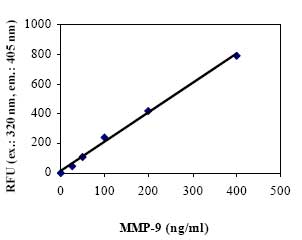CBA003 Sigma-AldrichInnoZyme™ Gelatinase (MMP-2/MMP-9) Activity Assay kit, Fluorogenic
Recommended Products
Overview
| Replacement Information |
|---|
Key Spec Table
| Detection Methods |
|---|
| Fluorogenic |
Pricing & Availability
| Catalogue Number | Availability | Packaging | Qty/Pack | Price | Quantity | |
|---|---|---|---|---|---|---|
| CBA003-1KIT |
|
1 kit |
|
— |
| Product Information | |
|---|---|
| Detection method | Fluorogenic |
| Form | 96 Tests |
| Format | 96-well plate |
| Kit contains | Gelatinase Substrate, pro-MMP-2 Positive Control, Inhibitor, APMA, Assay Buffer, 96-Well Plate, Plate Sealer, and a user protocol |
| Positive control | MMP-9 (Cat. No. PF140) |
| Quality Level | MQ100 |
| Applications |
|---|
| Biological Information | |
|---|---|
| Assay time | 2 - 6 h |
| Sample Type | Cell lysate, culture supernatant, tissue extract, plasma, serum, purified enzyme |
| Physicochemical Information | |
|---|---|
| Sensitivity | 20 ng/ml |
| Dimensions |
|---|
| Materials Information |
|---|
| Toxicological Information |
|---|
| Safety Information according to GHS |
|---|
| Packaging Information |
|---|
| Transport Information |
|---|
| Supplemental Information | |
|---|---|
| Kit contains | Gelatinase Substrate, pro-MMP-2 Positive Control, Inhibitor, APMA, Assay Buffer, 96-Well Plate, Plate Sealer, and a user protocol |
| Specifications |
|---|
| Global Trade Item Number | |
|---|---|
| Catalogue Number | GTIN |
| CBA003-1KIT | 04055977220827 |
Documentation
InnoZyme™ Gelatinase (MMP-2/MMP-9) Activity Assay kit, Fluorogenic SDS
| Title |
|---|
InnoZyme™ Gelatinase (MMP-2/MMP-9) Activity Assay kit, Fluorogenic Certificates of Analysis
| Title | Lot Number |
|---|---|
| CBA003 |
References
| Reference overview |
|---|
| Lauer-Fields, J.L., et al. 2003. J. Biol. Chem. 278, 18140. Chang, C., and Werb, Z. 2001. Trends Cell Biol. 11, S37. Kleiner, D.E., and Stetler-Stevenson, W.G. 1999. Cancer Chemother. Pharmacol. 43 (suppl.), S42. Cockett, M.I., et al. 1998. Biochem. Soc. Symp. 63, 295. Olson, M.W., et al. 1997. J. Biol. Chem. 272, 29975. Will, H., et al. 1996. J. Biol. Chem. 271, 17119. MacDougall, J.R., et al. 1995. Cancer Metastasis Rev. 14, 351. Liotta, L.A., et al. 1990. Semin. Cancer Biol. 1, 99. |
Brochure
| Title |
|---|
| Kit SourceBook - 2nd Edition EURO |
| Kits SourceBook - 2nd Edition GBP |















